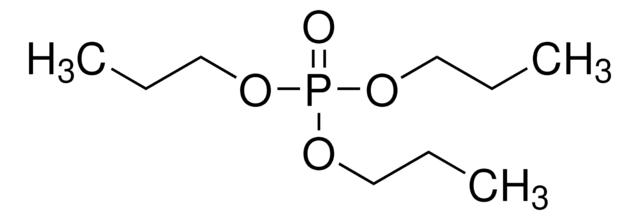8.18604
Phosphate de tributyle
for synthesis
Synonyme(s) :
TBP, TBPA
About This Item
Produits recommandés
Densité de vapeur
9.2 (vs air)
Niveau de qualité
Pression de vapeur
27 mmHg ( 178 °C)
7.3 mmHg ( 150 °C)
Essai
≥99.0% (GC)
Forme
liquid
Température d'inflammation spontanée
770 °F
Puissance
1550 mg/kg LD50, oral (Rat)
>3100 mg/kg LD50, skin (Rabbit)
Indice de réfraction
n20/D 1.424 (lit.)
pb
180-183 °C/22 mmHg (lit.)
Pf
−79 °C (lit.)
Température de transition
flash point 146 °C
Solubilité
6 g/L
Densité
0.979 g/mL at 25 °C (lit.)
Température de stockage
2-30°C
Chaîne SMILES
CCCCOP(=O)(OCCCC)OCCCC
InChI
1S/C12H27O4P/c1-4-7-10-14-17(13,15-11-8-5-2)16-12-9-6-3/h4-12H2,1-3H3
Clé InChI
STCOOQWBFONSKY-UHFFFAOYSA-N
Vous recherchez des produits similaires ? Visite Guide de comparaison des produits
Application
- Spontaneous Surface Convection and Extraction (Stripping) Rate in Systems with Tributyl Phosphate and Di(2-ethylhexyl) Hydrogen Phosphate.: This study investigates the spontaneous surface convection and extraction rates in systems involving tributyl phosphate (TBP) and di(2-ethylhexyl) hydrogen phosphate. The findings are crucial for improving the efficiency of chemical separations and extractions in analytical chemistry (Kizim and Golubina, 2020).
- The effect of radiolysis and thermally stimulated acid hydrolysis on tributyl phosphate and its solutions in ISOPAR-M.: This research explores the effects of radiolysis and thermally stimulated acid hydrolysis on TBP and its solutions in ISOPAR-M. Understanding these effects is essential for ensuring the stability and safety of TBP in various industrial applications, particularly in nuclear fuel reprocessing (Serenko et al., 2022).
- Protective Effects in the Radiolysis of Acidified Hydrocarbon Solutions of Tributyl Phosphate.: This paper examines the protective effects in the radiolysis of acidified hydrocarbon solutions of TBP. The study provides insights into mitigating the degradation of TBP under radiation, which is significant for its application in the nuclear industry (Serenko et al., 2022).
- Radicals from tributyl phosphate decomposition: a combined electron paramagnetic resonance spectroscopic and computational chemistry investigation.: Utilizing electron paramagnetic resonance (EPR) spectroscopy and computational chemistry, this study investigates the radicals formed from TBP decomposition. The results enhance the understanding of TBP′s stability and decomposition pathways under various conditions (Sosulin et al., 2023).
- Kinetics and mechanism of Eu(III) transfer in tributyl phosphate microdroplet/HNO3 aqueous solution system revealed by fluorescence microspectroscopy.: This research employs fluorescence microspectroscopy to reveal the kinetics and mechanism of Europium (III) transfer in a TBP microdroplet/HNO3 system. The findings contribute to the development of more efficient separation processes in analytical and nuclear chemistry (Miyagawa et al., 2022).
Remarque sur l'analyse
Density (d 20 °C/ 4 °C): 0.976 - 0.978
Identity (IR): passes test
Mention d'avertissement
Warning
Mentions de danger
Conseils de prudence
Classification des risques
Acute Tox. 4 Oral - Aquatic Chronic 3 - Carc. 2 - Skin Irrit. 2
Code de la classe de stockage
10 - Combustible liquids
Classe de danger pour l'eau (WGK)
WGK 2
Point d'éclair (°F)
294.8 °F
Point d'éclair (°C)
146 °C
Certificats d'analyse (COA)
Recherchez un Certificats d'analyse (COA) en saisissant le numéro de lot du produit. Les numéros de lot figurent sur l'étiquette du produit après les mots "Lot" ou "Batch".
Déjà en possession de ce produit ?
Retrouvez la documentation relative aux produits que vous avez récemment achetés dans la Bibliothèque de documents.
Les clients ont également consulté
Notre équipe de scientifiques dispose d'une expérience dans tous les secteurs de la recherche, notamment en sciences de la vie, science des matériaux, synthèse chimique, chromatographie, analyse et dans de nombreux autres domaines..
Contacter notre Service technique









